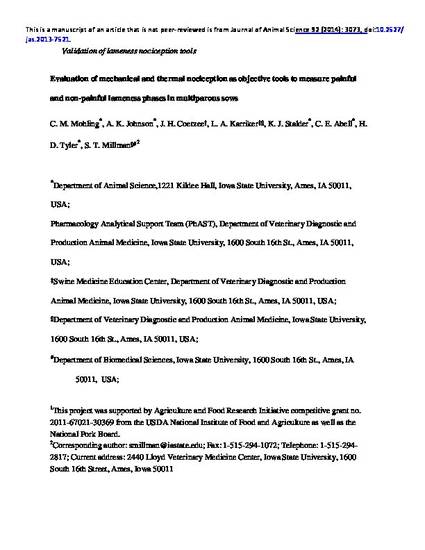
The objective of this study was to quantify pain sensitivity differences using mechanical nociception threshold (MNT) and thermal nociception threshold (TNT) tests when sows were in painful and nonpainful transient lameness phases. A total of 24 mixed parity crossbred sows (220.15 ± 21.23 kg) were utilized for the MNT test, and a total of 12 sows (211.41 ± 20.21 kg) were utilized for the TNT test. On induction day (D0), all sows were anesthetized and injected with Amphotericin B (10mg/mL) in the distal interphalangeal joint space in both claws of one randomly selected hind limb to induce transient lameness. Three days were compared: (1) D-1 (sound phase, defined as 1 d before induction), (2) D+1 (most lame phase, defined as 1 d after induction), and (3) D+6 (resolution phase, defined as 6 d after induction). After completion of the first round, sows were given a 7-d rest period and then the procedures were repeated with lameness induced in the contralateral hind limb. During the MNT test, pressure was applied perpendicularly to 3 landmarks in a randomized sequence for each sow: 1) middle of cannon on the hind limb (cannon), 2) 1 cm above the coronary band on the medial hind claw (medial claw), and 3) 1 cm above the coronary band on the lateral hind claw (lateral claw). During the TNT test, a radiant heat stimulus was directed 1 cm above the coronary band. The data were analyzed using the MIXED procedure in SAS with sow as the experimental unit. Differences were analyzed between sound and lame limbs on each day. For the MNT test, pressure tolerated by the lame limb decreased for every landmark (P < 0.05) when comparing D-1 and D+1. The sound limb tolerated more pressure on D+1 and D+6 than on baseline D-1 (P < 0.05). Thermal stimulation tolerated by the sound limb did not change over the 3 d (P > 0.05). However, the sows tolerated less heat stimulation on their lame limb on D+1 compared to D-1 levels (P < 0.05). Both MNT and TNT tests indicated greater pain sensitivity thresholds when sows were acutely lame.
Available at: http://works.bepress.com/anna_butters-johnson/67/

This is a manuscript of an article that is not peer-reviewed is from Journal of Animal Science 92 (2014): 3073, doi:10.2527/jas.2013-7521. Posted with permission.